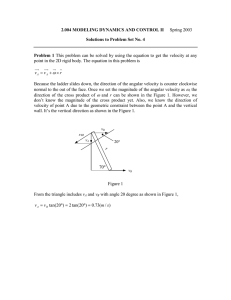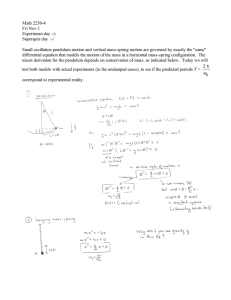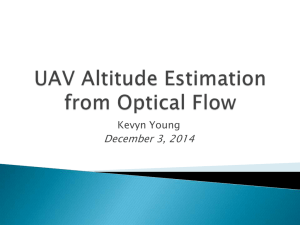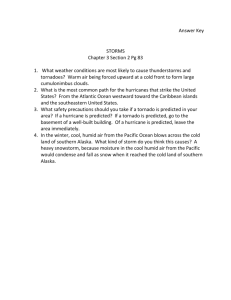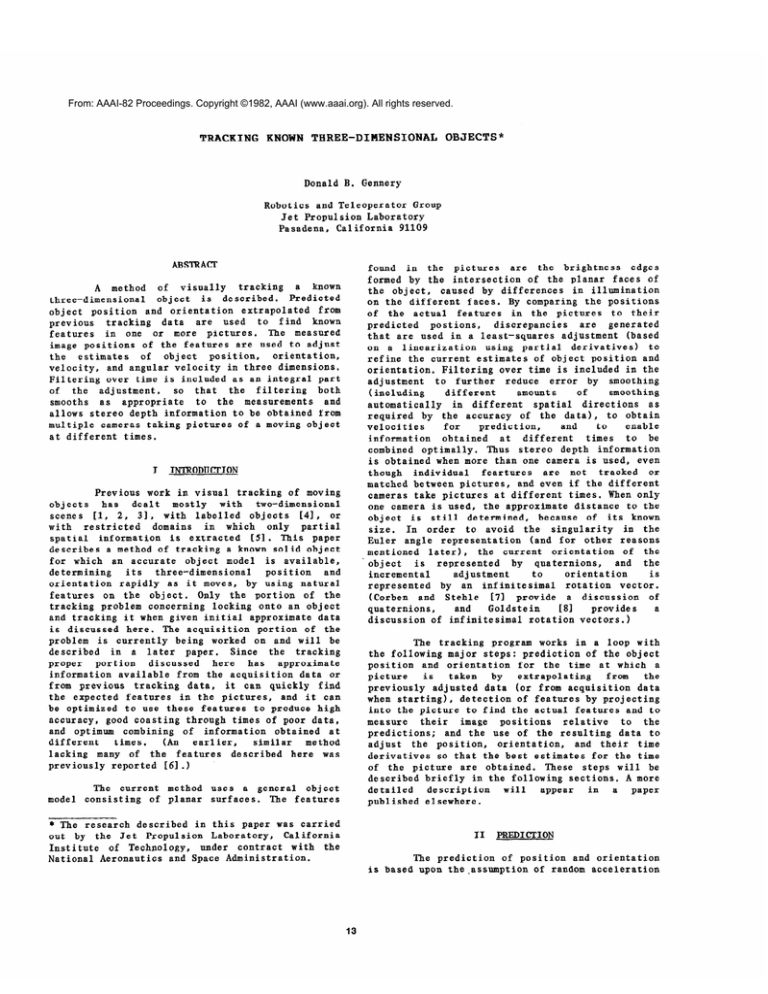
From: AAAI-82 Proceedings. Copyright ©1982, AAAI (www.aaai.org). All rights reserved.
TRACKING
KNOWN
THREE-DIMENSIONAL
Donald
B.
OBJECTS*
Gennery
Robotics
and Teleoperator
Group
Jet Propulsion
Laboratory
Pasadena,
California
91109
ABSTRACT
found
in
the
pictures
are
the
brightness
edges
formed
by the intersection
of the planar
faces
of
caused
by differences
in illumination
the object,
By comparing
the positions
on the different
faces.
of
the actual
features
in the pictures
to their
discrepancies
are
generated
predicted
postions,
that are used in a least-squares
adjustment
(based
on a linearization
using
partial
derivatives)
to
refine
the current
estimates
of object
position
and
orientation.
Filtering
over time is included
in the
adjustment
to
further
reduce
error
by
smoothing
smoothing
of
different
amounts
(including
automatically
in different
spatial
directions
as
required
by the accuracy
of
the data),
to obtain
and
to
enable
for
prediction,
velocities
different
times
to
be
obtained
at
information
depth
information
combined
optimally
. Thus stereo
is obtained
when more than one camera is used,
even
individual
feartures
are
not
tracked
or
though
and even if the different
matched between
pictures,
cameras
take pictures
at different
times,
When only
the approximate
distance
to the
one camera is used,
object
is
still
determined,
because
of
its
known
size.
In order
to avoid
the
singularity
in the
Euler
angle
representation
(and for
other
reasons
the current
orientation
of
the
mentioned
later),
and
the
object
is
represented
by
quaternions,
orientation
is
to
ad j us tment
incremental
represented
by an infinitesimal
rotation
vector.
(Corben
and Stehle
171 provide
a discussion
of
Goldstein
provides
a
qua ternions,
and
181
discussion
of infinitesimal
rotation
vectors.)
A method
of
visually
tracking
a known
three-dimensional
object
is
described.
Predicted
object
position
and orientation
extrapolated
from
tracking
data
are
used
to
find
known
previous
features
in one
or
more
pictures.
The measured
image positions
of the features
are used to adjust
orientation,
object
position,
estimates
of
the
and angular
velocity
in three
dimensions,
velocity,
Filtering
over time is included
as an integral
part
so
that
the
filtering
both
of
the
adjustment,
to
the
measurements
and
appropriate
smooths
as
allows
stereo
depth information
to be obtained
from
multiple
cameras
taking
pictures
of a moving object
at different
times.
I
II’iiODUCI’ION
Previous
work in visual
tracking
of moving
mostly
with
two-dimensional
dealt
objects
has
labelled
objects
[41,
or
scenes
Cl, 2, 31, with
restricted
domains
in
which
only
partial
with
spatial
information
is extracted
I51. This
paper
describes
a method of tracking
a known solid
object
for
which
an accurate
object
model
is available,
three-dimensional
position
its
and
determining
orientation
rapidly
as it moves,
by using
natural
Only
the portion
of
the
features
on the
object.
tracking
problem
concerning
locking
onto an object
and tracking
it when given
initial
approximate
data
The acquisition
portion
of the
is discussed
here.
problem
is currently
being
worked
on and will
be
described
in
a later
paper.
Since
the
tracking
portion
discussed
here
has
approximate
proper
information
available
from the acquisition
data or
from previous
tracking
data,
it
can quickly
find
the expected
features
in the pictures,
and it can
be optimized
to use these
features
to produce
high
accuracy,
good coasting
through
times of poor data,
and optimum
combining
of
information
obtained
at
earlier,
similar
different
times.
(An
method
the
features
described
here
was
lacking
many of
previously
reported
161 .)
mode 1
The current
consi sting
of
method
planar
The tracking
program
works
in a loop
with
the following
major steps:
prediction
of the object
position
and orientation
for
the time
at which
a
from
extrapolating
the
picture
is
taken
by
previously
adjusted
data
(or from acquisition
data
when starting),
detection
of features
by projecting
into
the picture
to find
the actual
features
and to
to
the
their
image
positions
relative
measure
predictions;
and the use of the resulting
data
to
adjust
the position,
orientation,
and their
time
derivatives
so that the best
estimates
for the time
of the picture
are obtained.
These
steps
will
be
described
briefly
in the following
sections.
A more
will
description
appear
in
a
de tailed
paper
pub1 ished elsewhere.
uses
a general
object
surf aces . The f eatures
* The research
described
in this
paper was carried
out by the Jet
Propulsion
Laboratory,
California
Institute
of Technology,
under
contract
with
the
National
Aeronautics
and Space Administration.
II
is
13
based
PREDICTION
The prediction
of
upon the.assumption
position
and orientation
of random acceleration
and angular
acceleration
(that
is,
a constant
power
spectrum
to
frequencies
considerably
higher
than
Since
random
the
rate
of
picture
taking)
.
imp1 ies
constant
expected
velocity,
acceleration
the predicted
position
itself
is obtained
simply by
adding
to the position
estimate
from the previous
of
the
previous
adjusted
adjustment
the
product
velocity
times
the elapsed
time since
the previous
dimensions.
three
picture,
for
each
of
the
Similarly,
the predicted
orientation
is obtained
by
rotating
from the previous
adjusted
orientation
as
if
the previous
adjusted
angular
velocity
vector
the
elapsed
applied
constantly
over
the
time
orientation
extrapolation
is
interval.
(This
particularly
simple when quaternions
are used.)
The
predicted
velocity
and angular
velocity
are simply
equal
to the
previous
adjusted
values.
However,
these predicted
values
must have appropriate
weight
in the
adjustment,
and,
since
the weight
matrix
should
be
the
inverse
of
the
covariance
matrix
(see,
for example,
Mikhail
1911, the computation
of
the covariance
matrix
of
the predicted
data will
now be discussed.
the
prev ions
covar i ante
matrix
of
The
adjusted
data
is denoted
by S. This
is a 12-by-12
are
components
of
there
three
matrix,
since
three
components
of incremental
rotation,
position,
three
components
of velocity,
and three
components
of angular
velocity
(assumed
to be arranged
in that
To
a
approximation,
the
order
first
in
S).
covariance
matrix
‘s of the predicted
data
can be
obtained
by
adding
to
S terms
to represent
the
additional
uncertainty
caused by the extrapolation.
These must include
both of the following:
terms to
position
uncertainty
in
and
increase
the
orientation
caused
by uncertainty
in the velocity
and angular
velocity
that
were
used
to
do the
terms
to
increase
extrapolation,
and
the
uncertainty
in velocity
and angular
velocity
caused
by the random acceleration
and angular
acceleration
over
the
extrapolation
interval.
The
occur ing
former
can
be
produced
by
using
the
effect
following
12-by-12
transformation
matrix:
A
=
I
0
ZI
0
0
I
0
ZI
0
0
I
0
0
0
0
I
i
where I is the 3-by-3
identity
matrix
and z is the
elapsed
time
interval
of
the extrapolation.
Then
the covariance
matrix
can be transformed
by this
and additional
terms can be added for
the
matrix,
latter
effect,
as follows:
‘s Y
ASAT
+
0
0
0
0
0
0
az1
0
0
0
0
0
0
0
0
alz1
where a and a are the assumed values
of the power
spectra
of acceleration
and angular
acceleration,
respectively,
and the
superscript
T denotes
the
(Mikhail
191
provides
the
matrix
transpose.
necessary
background
information
on
matrix
algebra.)
The larger
are the values
of a and a, the
larger
will
be the
uncertainty
in the
predicted
values
as
indicated
by
3,
and
thus
the
less
smoothing
over
time
will
be
produced
in
the
adjustment.
In
practice,
the
above
matrix
multiplications
are
multiplied
out
so
that
the
actual
computations
are
expressed
in
terms
of
3-by-3
matrices.
This
is
computationally
faster
since
A is so sparse.
However,
for
greater
accuracy
two
additional
effects
are included
in the implemented
program.
First,
the
effect
on
orientation
of
uncertainty
in the previous
orientation
and angular
velocity
will
be influenced
by the rotation
that
has occured
during
the
time
r.
This
causes
some
modification
of
the A matrix.
Second,
additional
terms involving
a and a are added to 3 to reflect
the influence
that
the random acceleration
during
the just
elapsed
time
interval
z has on position
and
orientation.
These
refinements
will
be
described
in another
paper.
III
DETECTION @
FEATURES
Once
the
predicted
object
position
and
orientation
are
available
for
a picture,
the
vertices
in the object
model that
are predicted
to
be visible
(with
a margin of safety)
are projected
into
the picture
by using
the known camera model
[lOI.
The lines
in the picture
that
correspond
to
edges of the object
are computed
by connecting
the
appropriate
projected
vertices.
Analytical
partial
derivatives
of
the
projected
quantities
with
respect
to the object
position
vector
and object
incremental
infinitesimal
rotation
vector
are also
computed.
Brightness
edges
are searched
for near the
positions
of
the predicted
lines.
The brightness
edges
elements
are
detected
by a modified
Sobel
thresholding
operator
( including
and
thinning),
which we have available
both
in software
form and
in special
hardware
that operates
at the video
rate
The program
only
looks
for
edge
elements
1111.
every
three
pixels
along
the line,
since
the Sobel
operator
is three
pixels
wide.
For each of these
positions
it searches
approximately
perpendicularly
to the line.
Currently
it accepts
the nearest
edge
element
to the predicted
line,
if it is within
five
pixels.
However,
a more elaborate
method has been
devised.
This new method varies
the extent
of the
search
according
to the accuracy
of the predicted
data,
accepts
all
edge elements
within
the search
width,
and gives
the edge elements
variable
weight
according
to
their
agreement
with
the
predicted
line
and
their
intensity.
This
method
will
be
described
in a later
paper.
In principle,
the position
of each detected
element
could
be
used
directly
in
edge
the
adjustment
described
in
the
next
section.
The
would
be the
perpendicular
observed
quantity
ei
distance
from
the predicted
line
to the detected
edge element,
the l-by-6
partial
derivative
matrix
be the partial
derivatives
of -ei
with
Bi would
respect
to the three
components
of object
position
incremental
object
and
three
components
of
of
the
observation
rotation,
and the
weight
Wi
its
the
reciprocal
of
the
square
of
would
be
(accuracy).
(Currently,
this
standard
deviation
standard
deviation
is
a given
quantity
and
is
assumed to be the same for all
edge elements.)
weight
matrix
‘s-l.
(Giving
the
predicted
values
weight
in
the
solution
produces
the
filtering
action,
similar
to a Kalman filter,
because
of the
memory of
previous
measurements
contained
in the
predicted
information.)
Therefore,
the adjustment
including
the
information
contained
in
the
predicted
values
in principle
could
be obtained
as
follows:
for
computational
efficiency
the
However,
program
uses
a mathematically
equivalent
two-step
a corrected
line
is computed
by a
process.
First,
the
fit
to
least-squares
perpendicular
discrepancies
from the predicted
line.
In effect,
the
the
quantities
obtained
are
perpendicular
corrections
to the predicted
line
at its
two end
which form the 2-by-1
matrix
Ei,
and the
vertices,
corresponding
2-by-2
weight
matrix
Wi. Bi is then
the
2-by-6
partial
derivative
matrix
of
-Ei
-1
S
However,
using
the
above
is
equation
inefficient
and may present
numerical
probl ems,
since
the two matri ces to be inverted
are 12-by-12
and may be nearly
singular.
If
‘s is partitioned
into
6-by-6
matrices
as follows,
with
ADJUSTMENT
Now
the
nature
of
the
adjustment
to
position
and orientation
will
be discussed.
If no
filtering
were
desired,
a weighted
least
squares
solution
could
be
done,
ignoring
the
predicted
except
as
initial
to
be
values
approximations
corrected.
The standard
way of doing
this
[9, 121
is as follows:
N
the
following
mathematically
equivalent
form
terms
of
6-by-6
matrices
and
i-vectors
can
produced
by means of some matrix
manipulation:
sPP
=
(1 + ~ppNrlSpp
SW
=
(1 + sppNrlBm
SW
=
‘SW -
P
=
f’ + sppc
v
= ‘3 + s&c
B;WiBi
=
i
C
+ 3-l
[ii]=[F]+$1
respect
to
the
object
position
and
incremental
these
orientation.
Second,
quantities
for
each
predicted
line
are used in the adjustment
described
in the next section.
IV
=
=
B;WiEi
g&N(I
in
be
+ ‘sPPN)-l~PV
i
P
where
Bi
is
the
=
matrix
H + N-lC
of
partial
the ith
set of observed
quantities
the
parameters
being
adjusted,
matrix
of the ith set of observed
Not
only
computationally,
(I + ‘sPPN) is
derivatives
of
with respect
to
Wi is
the weight
quantities,
Ei is
both
a vector
made up of
the
ith
set
of
observed
P is
the
vector
of parameters
being
quantities,
adjusted,
and fr is the initial
approximation
to P.
The covariance
matrix
of
P, which
indicates
the
accuracy
of the adjustment,
is then N-1
For the
of the
case
at hand,
P is 6-by-1
and is composid
components
of position
and incremental
orientation,
and C is 6-by-l.
N is 6-by-6,
The meanings
of Ei’
this
case
were
described
in the
wj,# and Bi for
previous
‘s,
is
this
form
more
efficient
but
the
matrix
to
be
inverted
guaranteed
to be nonsingular,
because
and N are non-negative
definite.
The first
three
elements
of
P from
the
above form the new adj usted
position
vector
of the
object . The last
three
elements
form an incr emental
rotation
vector
used
to
correct
the
object
orientation.
This
could
be used directly
to update
the
rotat ion
matrix
as
expl ained
by Goldstein
since
the
181) , but ,
primary
representation
of
orientation
in the implemented
tracker
is in terms
of qua ternions,
it is used
instead
to update
the
quaternion
that
represents
orientation,
and the
rotation
matrix
is computed
from that.
This method
also
makes convenient
the normalization
to prevent
accumulation
of numerical
error.
(The relationshin
between
quaternions
and rotations
is described
bE
Corben and Stehle
171 .) The covariance
matrix
S of
th+e adjusted
data is formed by assembling
Spp, SPV,
and SVV into
a 12-by-12
matrix,
similarly
to
%vs
58.
section.
The
velocity
and
angular
velocity
are
included
in the
adjustment
by considering
twelve
adjusted
parameters
consisting
of the six-vectors
P
and V, where V is composed
of the three
components
of
velocity
and the
three
components
of
angular
velocity.
The measurements
which
produce
N and C
above
contribute
no
information
directly
to
v.
the
predicted
values
fr and v can
be
However,
considered
to be additional
measurements
directly
on P and V with
covariance
matrix
‘s,
and thus
15
Figure
1.
Digitized
picture
Figure
2.
Results
from
Figure
Figure
3.
camera.
Results
from
next
from
left
camera.
1.
picture
from
right
16
Figure
4.
camera.
Results
from
next
Figure
object.
5.
Results
from
right
Figure
later.
6.
Results
from
left
picture
camera
camera
from
left
with
obscuring
five
pictures
V
RESULTS
Figures
1, 2, 3, and 4 show the tracker
in
The
object
being
tracked
(a
hexagonal
is 203 mm tall
and is
moving
upwards
at
Pictures
from
two cameras
were
16 mm/set.
values
used
for
the
alternately.
The
a = 1 mm2/sec3
and
acceleration
parameters
were
assumed
standard
a = 0.0001
radian2/sec3.
The
deviation
of the edge measurements
was one pixel.
The software
version
of the edge detector
was used.
which
runs
on a General
Automation
The program,
was
able
to
process
each
SPC-16/ 85
computer,
picture
in this
example
in 1.6 seconds,
so that the
complete
loop
through
both
cameras
required
3.2
seconds.
(When the hardware
edge detector
is used,
the time per picture
in a case
such as this
is only
0.5 second.)
action.
prism)
about
taken
Figure
1 shows
the
raw
digitized
image
pictures
corresponding
to Figure
2. For successive
and
left
cameras,
from
the
left,
right,
Figures
2.
3,
and
4
show
the
respectively,
following
information.
In a window that the program
puts
around
the predicted
object
for
applying
the
the raw digitized
picture
software
edge detector,
has been replaced
by the detected
brightness
edges
(showing
as faint
lines).
(With
the hardware
edge
detector
the entire
picture
would be so replaced.)
are
predicted
lines
Superimposed
on
this
the
(showing
as
corresponding
to edges
of
the object
brighter
lines).
The
bright
dots
are
the
edge
elements
which were used in the adjustment,
(These
may be somewhat
obscured
in the figures
when they
lie directly
on the predicted
lines.)
The program
is able
to tolerate
a moderate
of
missing
and
spurious
edges.
This
is
amount
because
it looks
for edges only near their
expected
because
the typical
abundance
of edges
positions,
overdetermination
in
the
considerable
produces
of the smoothing
produced
adjustment
, and because
by
the
filtering.
Figures
5 and 6 (similar
to
and
4)
show
an
example
of
an
Figures
2,
3,
obscuring
object
passing
in front
of
the tracked
object
without
causing
loss
of track.
Figure
5 is
from the right
camera,
and Figure
6 is from the
left
camera five
pictures
later
(so that
there
are
two pictures
from the left
camera and two from the
right
camera
between
these
in time
that/are
not
shown) .
ACKNOWLEDGMENTS
The programming
of
the
tracker
was done
primarily
by Eric
Saund,
with
portions
by Doug
Varney
and Bob Cunningham.
Bob Cunningham assisted
in conducting
the tracking
experiments.
REFERENCES
111
“Analysis
Techniques
H.-H.
Nagel,
Fourth
International
Sequences,”
Conference
on
Pattern
Recognition,
November 1978,
pp. 186-211.
for
Image
Joint
Tokyo,
17
c21
W. N. Martin
and J.
K. Aggarwal,
Scene Analysis,”
Computer Grauhics
Processing
7 (19781,
pp. 356-374.
“Dynamic
and Imane
-
131
A. L. Gilbert,
M. II. Giles,
G. 1. Flachs,
R.
B. Rogers,
and Y. H. TJ, “A Real-Time
Video
Tracking
System,”
IEEE
Transactions
on
Pattern
Analvsis
and
Machine
Intellinen=
PAYI(19801,
pp. 47-56.
141
H. F. L. Pinkney,
“Theory
and Development
of
an On-Line
30 Hz Video
Photogrammetry
System
for
Real-Time
3-Dimensional
Control,
”
Proceedings
of
the
ISP
SvmDos ium
on
PhoDs
InXtrv,
Stockholm,
August 1978.
r51
W. Roach
J.
Tracking
of
Transactions
Intelligence
161
Saund,
D.
B.
Gennery,
E.
and
R.
T.
Cunningham,
“Visual
Tracking
in
Stereo,”
Joint
Automatic
Control
Conference,
sponsored
by ASME, University
of Virginia,
June 1981.
[71
H.
C.
Mechanics
CSI
H.
Goldstein,
Classical
Edition),
Addison-Wesley,
[91
Mikhail
(with
E.
M.
Ackermann),
Observations
Harper and Row, 1976.
[lOI
Y. Yakimovsky
for Extracting
from a Stereo
Grauhics
and
195-210.
r111
Eskenaz i
M.
R.
and
J.
Wilf,
“Low-Leve 1
Processing
for Real-Time
Image Analysis,”
Jet
Propulsion
Laboratory
Report
79-79.
Cl21
D. B. Gennery,
“Mode 11 ing the Environment
of
an Exploring
Vehicle
by
Means
of
Stereo
Vision,”
AIM-339,
STAN-CS-80-805,
Computer
Science
Dept.,
Stanford
University,
1980.
and J.
B. Aggarwal,
“Computer
Objects
Moving
in Space,”
IEEE
on Pattern
Analysis
--and Machine
PAHI(19791,
pp. 127-135.
Corben
and
P.
(Second
Edition),
Stehle,
Wiley,
Mechanics
1980.
contributions
and Least
Classical
-1960.
(Second
by
F.
Squares,
and R. T. Cunningham,
“A System
Three-Dimensional
Measurements
Pair
of TV Cameras,”
Computer
Image Processing
7 (19781,
pp.

